Customer reviews play an important role in convincing people to use your business. When someone shares a positive opinion with others, it serves as a form of social proof. This validation from others makes people more likely to become customers.
According to a survey from BrightLocal, over 90% of consumers say positive reviews make them more likely to choose a business.
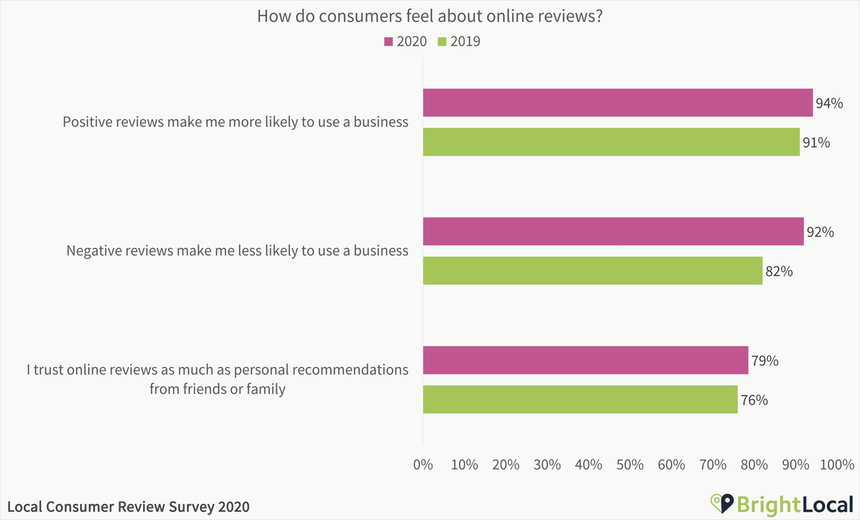
In the past, reviews were strictly word of mouth. But in the digital world, customer reviews come in a variety of forms. You can find reviews about businesses or specific products across all sorts of web properties. In this post, we’ll look at some examples of customer reviews and cover some strategies you can use to get more reviews of your own.
Examples of customer reviews
1. Product reviews
A customer gives the purchased item a star rating (generally on a scale of 1-5). They also provide written feedback about the item.
Product reviews can appear on your own website or a marketplace like Amazon. They are critically important on marketplaces where you compete with other sellers. Most customers will compare the reviews for different items before making their purchase.
Below is an example of a negative review for a product on Amazon:

2. Testimonial and quote reviews
Receiving quotes and testimonials from previous customers is one of the most common forms of customer reviews. They are easy to implement, as you use your content management system to add the review to your website. You can showcase quote reviews on your homepage, services page, or about us page.
Here is an example of a quote review on Ahrefs.com for their suite of SEO tools:
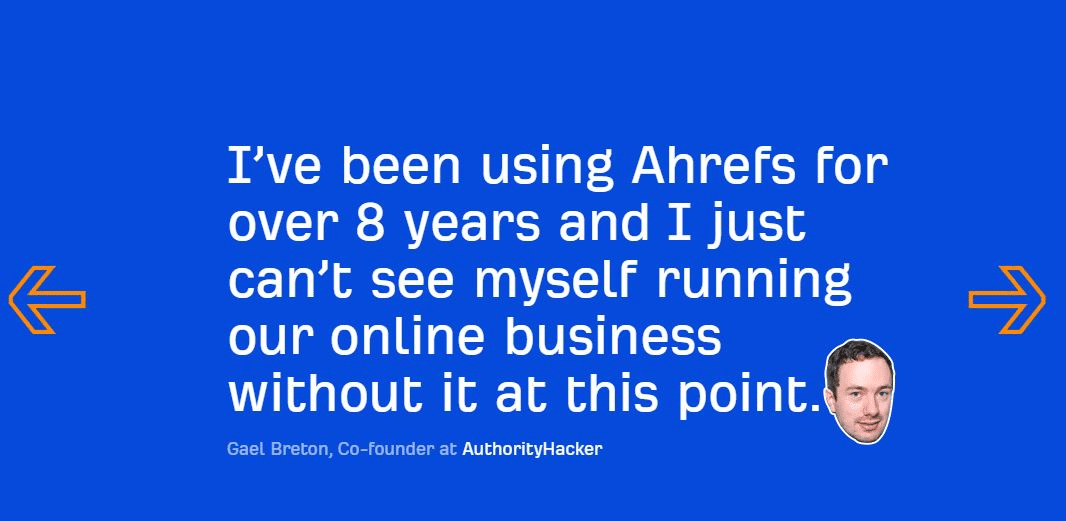
3. Third-party review sites
Third-party review sites provide consumers with an independent database of reviews for businesses across a large range of industries. Examples of review sites include Yelp, Google Reviews, TrustPilot.
Companies are often left out of the review process for third-party sites entirely. Many customers will organically visit their preferred review site after a purchase to voice their opinion. Because of this, people are more trusting of reviews on independent sites. Reviews seem more authentic, and consumers can know for certain that a business isn’t deleting its negative feedback.
Here is a review for BestBuy.com on the third-party review site Trustpilot:

4. Article and blog reviews
This form of review is a type of web content where someone reviews a product in a blog post.
With blog reviews, the reviewer has the ability to analyse the business or product in much greater detail. You can also find comparison reviews where someone breaks down multiple products in a single piece of content.
Below is an example of the heading for an article review of Thrive Market:
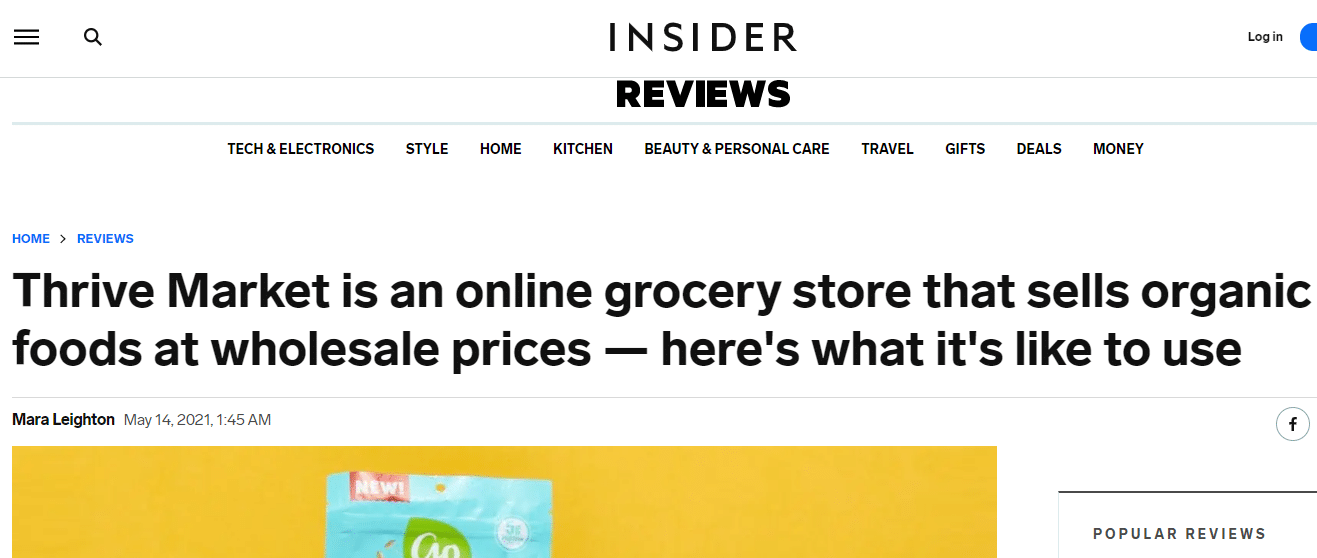
Strategies to get more customer reviews
Reviews can have a tremendous impact on your business, but they are not always easy to get. Only a small percentage of customers will go out of their way to leave a review after a purchase.
If you want to maximise the number of reviews your business receives, you’ll need to implement a strategy and process for collecting them. The best way to gather reviews will depend on the type of reviews you are trying to collect.
Here are some practical steps you can take to get more reviews from your customers.
1. Build long-term relationships with your customers
The first step to gathering more reviews is to build strong, long-term relationships with your customers. Loyal customers are more interested in a company’s success and want to see the business grow. By sharing their positive experience with others, reviewers can help the business attract more customers.
You can strengthen your connection with customers by providing great products and customer service, engaging on social media, offering rewards, and more.
2. Use your existing customer base
Building off the prior point, once customers become loyal brand advocates, you can use them to spread the reach of your business.
Your existing customer base can engage with their peers, encouraging them to use your business as well. As you grow your customers, you can continue to build strong relationships, making people more likely to leave you reviews.
3. Offer coupons and discounts
You can incentivise purchases and get more reviews by offering discounts and other promotional offers to your customers. People will feel appreciative after getting a good deal and feel more inclined to leave a review if they had a positive experience with your business.
4. Ask for reviews on your social media pages
Consumers use social media to discover and engage with new brands. They’ll ask questions and talk to other users to learn about a company’s products or services. Many people share their reviews and opinions directly on a brand’s social media profile. You can reach out to these people and ask them to share their reviews on other platforms such as your website, third-party review site, or marketplace.
Another effective social media strategy for gaining reviews is to post previous reviews on your profiles. You can tweet a customer’s testimonial or attach a screenshot of a product review to a Facebook post. Seeing other people’s reviews being featured will encourage customers to leave reviews of their own.
5. Answer customer questions
Many customers use the web to ask specific questions about businesses or products. These questions can appear in various places, such as forums or directly on an Amazon product page.
Here is an example of the customer questions for an Amazon product:
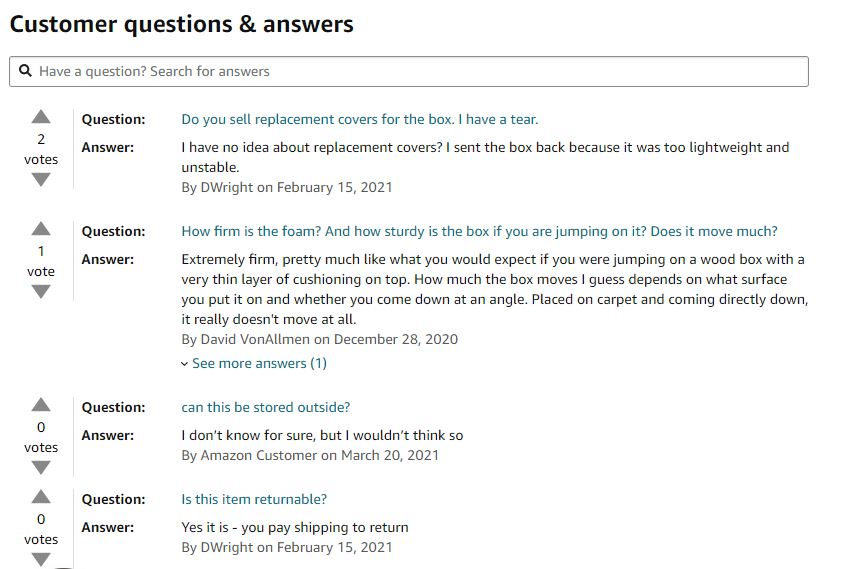
You can leverage these questions to obtain more reviews by actively responding to customers’ questions with useful answers. People will feel appreciative of you taking the time to address their concerns and will be more likely to share their positive feedback with others.
6. Request review features
Some online marketplaces (such as Amazon) give you the ability to request a review from your customers. You can find the Request a Review button in your Seller Central account, next to the details for each order.
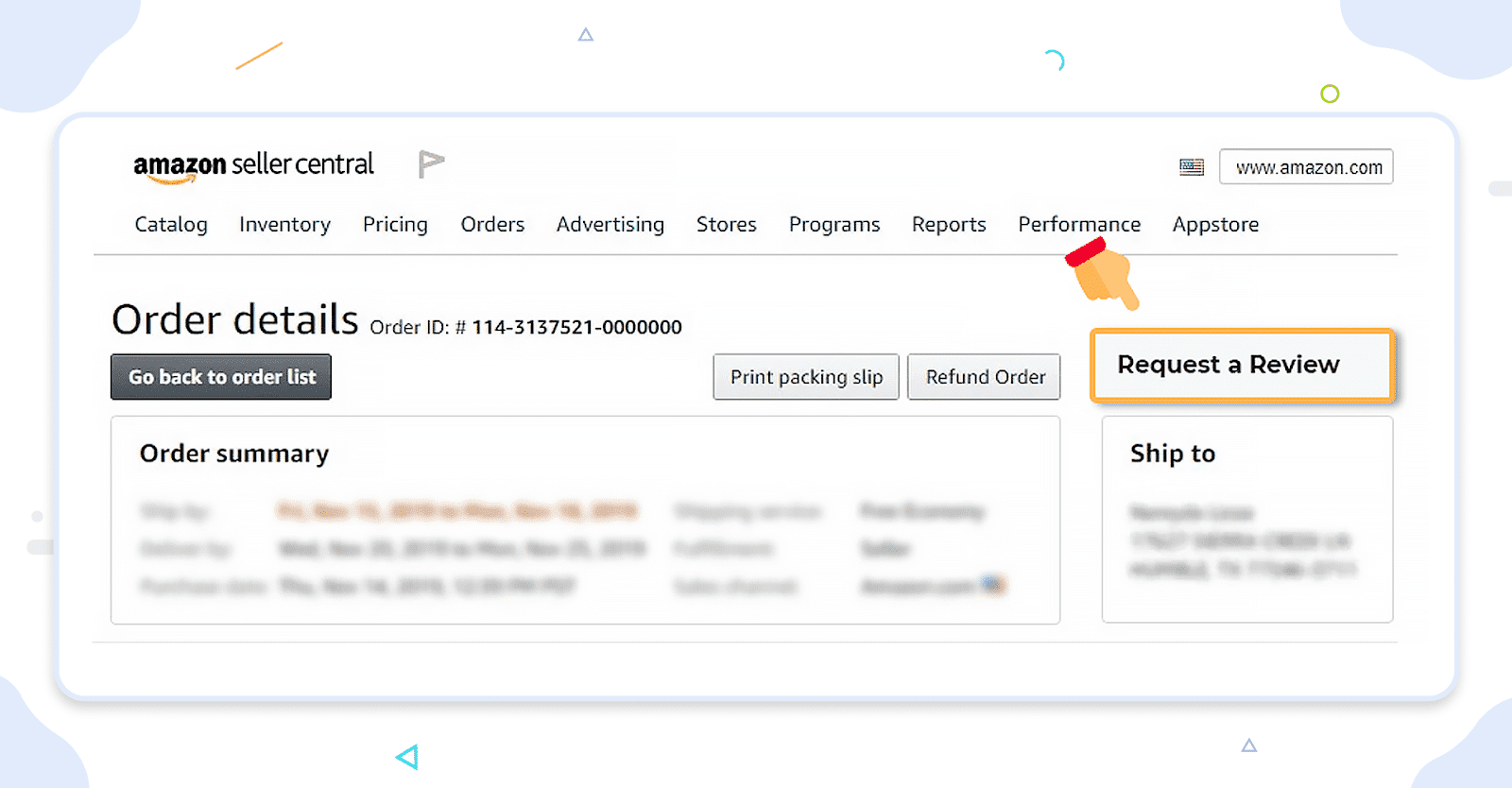
When you request a review, a follow-up email is automatically sent to the customer. You can only send one follow-up, but the message can still prove quite effective in getting more reviews. Customers already receive an email from Amazon asking for a review—the second email helps remind them to complete the process if they have not. The Request a review feature is available for the period four to 30 days after the purchase.
7. Use chatbots
Chatbots are effective tools for automating repetitive tasks. You can program a chatbot to collect reviews from your previous customers without manually reaching out after purchase.
When someone visits your website, a chatbot can trigger a message asking for a review. The message could link to a third-party review site or the user’s previous orders on their account page. You can refine the targeting for the chatbot, so it only shows to previous buyers.
You can also build chatbots that work with Facebook Messenger and SMS to reach your customers through other touchpoints.
What you should NEVER do to get reviews
Now that we’ve looked at effective ways to get customer reviews let’s examine some tactics you want to avoid. There are several ways to boost your review total artificially, but they are not worth the potential negative consequences they can have on your business.
Offering a free product, money or discounts in exchange for a review
If you sell on Amazon, you are forbidden from offering customers free products for a review. You are also unable to offer discounts for reviews. You can give away coupons to boost brand loyalty, but not in direct exchange for a review.
You want to make sure you completely understand the rules for incentivised reviews on any other platform that you use. Violating those terms could result in you losing the ability to sell on the marketplace.
Buying reviews from third-party websites.
Whether you sell on a marketplace or your own website, it is never a good idea to buy reviews from a third-party site. If your audience finds out that you’re using fake reviews to mislead them, it can do serious damage to your business’ reputation.
Naturally, all online marketplaces and review sites have strict rules against buying reviews. If you are caught acquiring fake reviews, there will be consequences. For example, if Yelp believes you have bought reviews, they will add a consumer alert to your business page. This alert warns consumers that you are trying to manipulate your reviews. A negative impact like this will turn consumers away just as fast as a negative review.
Ask your friends and family to leave reviews for your product.
If you sell on marketplaces like Amazon, this is another restriction you need to be aware of. You are not allowed to get biased parties (friends, family, etc.) to write positive reviews on your behalf.
This tactic shouldn’t be a major focus anyway as it will not allow you to get reviews at scale. Instead, it would help if you focused on building a system to generate consistent reviews.
Ask your customer to leave ONLY a positive review
If you ask a customer for a review it must be for an open, honest review. You can’t simply reach out asking them to give you positive feedback. Your communications should include wording like
“tell us about your experience”, not “tell the world our product is the best”.
Other ways to increase your exposure and sales
Reviews play an important part in winning customers, but they are not the only way to improve your product’s sales. Here are some other ways you can increase consumers’ confidence in your business, boosting sales in the process:
High-quality products or services
The best way to increase your sales is to offer high-quality products and services. When you provide something of real value, customers will naturally gravitate towards your business. Over time, reviews will come in on their own as customers will want to let others know how great your business is.
Optimise Your Listing with the Right Keywords
The more exposure your business receives, the more chances you have to turn prospects into customers. A cost-effective way to get more eyes on your products and services is to optimise for SEO. With strong Amazon SEO rankings, your products appear at the top of the results for relevant queries in your niche market.
The first step to SEO optimisation is to know which keywords to target. Once you have your target keywords, you need to add them to the important areas on your product listing. These areas include titles, bullet points, additional descriptions, and image alt text. By including your target keywords, Amazon can understand what the page is about and rank it accordingly.
Below we can see an example of a description that has been well optimised for the keywords “plyo box” and “plyometric box”:
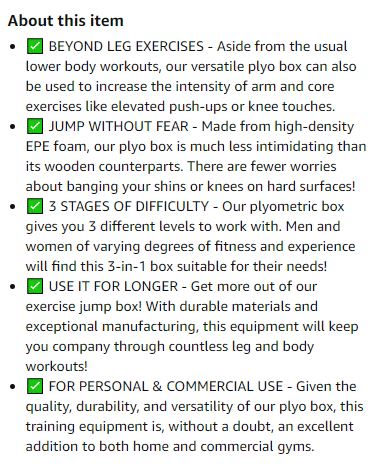
Use High-Quality Photos
Online shoppers rely on images to get a true sense of an item. If your images are low quality, many customers won’t feel comfortable making a purchase. You can improve the performance of your eCommerce products by including high-quality photos for every listing.
Use professional cameras for images and ensure there is adequate lighting. It is also important to have multiple images for each item as consumers expect various images with every listing.
Price products competitively
While today’s consumers are placing increasing importance on the shopping experience, price is still one of the biggest factors impacting purchasing decisions. Shoppers will compare prices from multiple businesses before placing an order. You can increase your sales by actively monitoring your competitors’ prices and appropriately pricing your products and services.
Optimise for mobile devices
The majority of today’s web traffic comes from mobile devices. As such, it is critical to optimise the customer experience for mobile users. This means fast-loading pages and elements that are easily readable and accessible.
You can consider developing a mobile eCommerce application as it is the easiest way to create a streamlined mobile experience.
Conclusion
Customer reviews are a must-have for businesses across industries. They reinforce your unique value offering and open the door to an expanded audience. Whether you sell products on an eCommerce marketplace or services through your own website, you should define a replicable system for gathering reviews.
This post was written by the AMZScout Amazon Expert Team. AMZScout is one of the top Amazon research tools for online sellers. They share their expertise and valuable tips to guide sellers to success.
Originally published Jun 02, 2021, updated Jan 16, 2023



